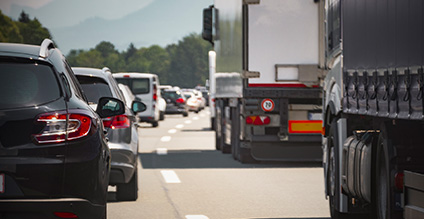Being involved in a semi-truck accident can leave you facing devastating injuries and financial strain. The aggressive Milwaukee semi-truck accident lawyers at Warshafsky Law Firm are here to help. Our lawyers fight passionately to secure maximum compensation. Our award-winning attorneys have extensive experience building strong negligence claims against semi-truck companies and drivers who fail to exercise reasonable care on the roads. At Warshafsky, you are more than just another client - we treat every person injured by a semi’s negligence like family.
Were you hit by a semi?
A "semi" is a colloquial term often used to refer to a semi-truck, which is also known as a tractor-trailer, big rig or 18-wheeler. A semi-truck includes two main components.
- Tractor: The front part of the semi, known as the tractor or semi-truck, contains the engine, driver's cab and controls. The tractor is responsible for providing the power needed to move the entire vehicle. It usually has two axles and is designed to connect with the rear trailer.
- Trailer: The trailer, which is attached to the tractor, is a separate, unpowered unit used for carrying cargo. Trailers come in various types and are specialized for different types of cargo or purposes. The trailer is supported by a set of wheels at the rear and has additional axles to distribute weight as needed.
Characteristics of Semi-Trucks on Wisconsin Roads
| Feature | Semi |
|---|---|
| Size and Weight | Large and heavy; GVWR up to 80,000+ lbs. |
| Cargo Capacity | High, for large and heavy loads |
| Towing Capacity | High, often tens of thousands of pounds |
| Configuration | "18-wheeler" with multiple axles |
| Cargo Type | Diverse, including large, heavy and bulk items |
| Transport Distance | Long-distance, intercity or interstate |
What Do You Call a Truck? It Depends!
What you call a truck varies significantly across the United States. In some regions, it's commonly referred to as a "semi-truck," while in others, it might be called a "tractor trailer" or "18-wheeler." While the most common name for a large truck is “semi-truck" in the Midwest, Southwest, and Central US, 18-wheeler is the most common name for a large truck in the Southern US. Tractor trailer is the unanimous name for a large truck in New England and in the Northeast.
Semi-truck accidents are on the rise
According to the National Safety Council, the number of large trucks involved in deadly crashes rose significantly in 2021. In 2021, 5,700 large trucks contributed to fatal accidents - an 18% increase from 2020 figures. Looking over the past decade, the rate has climbed by 49% since 2011.
When factoring in miles traveled, the fatal crash involvement rate per 100 million truck miles shows a 7% jump versus 2020 data. Over the last 10 years, the rate per mile traveled has surged by 22%.
Large trucks accounted for:
- 9% of all vehicles involved in fatal crashes
- 5% of all registered vehicles
- 10% of total vehicle miles traveled
*The data defines large trucks as medium and heavy trucks over 10,000 pounds gross vehicle weight, excluding buses and motorhomes. The statistics encompass both commercial semis and private non-commercial vehicles meeting the size criteria.
Types of semis on Wisconsin roads

Dry Van Trailers Dry van trailers are among the most common types of semi-truck trailers, used to transport general goods. Because they are prevalent on the road, they are involved in a significant number of accidents.
Cause of Accidents: The most common accidents involving dry van trailers are rear-end collisions, often caused by inadequate following distance or sudden stops.

Refrigerated (Reefer) Trailers Reefer trailers are used for transporting temperature-sensitive cargo, including perishable foods and pharmaceuticals.
Cause of Accidents: Accidents with reefer trailers frequently result from cargo shifts due to improper loading or poor temperature control.

Tankers Tankers transport liquids or gasses, including hazardous materials. Accidents involving tankers can be particularly dangerous due to the risk of spills and chemical exposure
Cause of Accidents: Tanker accidents often involve rollovers, especially when taking turns at high speeds, due to the liquid's sloshing effect.

Flatbed Trailers Flatbed trailers are often used to transport oversized or irregularly shaped cargo, which may pose unique challenges in securing and handling the load.
Cause of Accidents: Common accidents with flatbed trailers include cargo that falls off due to inadequate securing or overhanging loads.

Car Haulers Car haulers transport multiple vehicles, and accidents can occur when vehicles being transported are not properly secured or during loading and unloading processes..
Cause of Accidents: Accidents with car haulers can occur during loading and unloading processes when vehicles are not properly secured.

Loggers Loggers transport logs from forests to mills, often operating in challenging off-road conditions. Loggers may be involved in accidents when logs are not properly secured.
Cause of Accidents: The most common accidents involving logging trucks are rollovers on uneven terrain or while navigating sharp curves.

Heavy Haulers Heavy haulers are designed for transporting extremely heavy or oversized cargo, which can present unique challenges in terms of weight distribution and route planning.
Cause of Accidents: Accidents with heavy haulers may involve difficulties with weight distribution, which can result in tipping or loss of control.
Experienced semi-truck accident lawyers in Milwaukee
Warshafsky Law Firm is a team of highly experienced semi-truck accident lawyers in Milwaukee. With a strong track record of success, we are dedicated to fighting for the rights of accident victims and securing the compensation they deserve. Our legal experts are well-versed in the complexities of semi-truck accident cases, offering expert guidance and representation. We deliver justice and secure the best possible outcomes for our clients involved in semi-truck accidents in Wisconsin.
Semi-truck accident FAQ
What are the common causes of semi-truck accidents?
Driver fatigue, speeding, distracted driving and adverse weather conditions are the largest contributors to semi-truck accidents.
What should I do if I'm involved in a semi-truck accident?
If injured, your top priority should be seeking necessary medical attention and contacting a semi-truck accident lawyer. It's also important to contact law enforcement, gather pertinent information and document the accident scene, which is valuable for both insurance claims and legal purposes.
How are liability and responsibility determined in semi-truck accidents?
Determining liability can be complex in semi-truck accidents. It often involves investigations, examination of driver records and vehicle maintenance history. Legal experts and insurance adjusters play key roles in assessing responsibility.
What are the regulations governing the trucking industry to prevent accidents?
Federal and state regulations are in place to promote safety in the trucking industry. These rules cover areas such as driver hours-of-service, vehicle maintenance, cargo securement and weight limits.
What can I do to stay safe when sharing the road with semi-trucks?
Avoid blind spots, maintain a safe following distance and exercise caution during lane changes and passing. Trucks take longer to stop than smaller vehicles.







